Visit Jillson House Museum
Historic Walking Trail
A walking tour of Windham/Willimantic's most historically important locations.
“This project made possible with the generous support of the Eastern Regional Tourism District through their 2025 Regional Marketing Partnership Program.”
Welcome to Willimantic! The city section of the town of Windham derives its name from the Mohegan language which may mean “land of swift running waters.” The Willimantic River flows down through the town and water power attracted industries that produced thread and cloth during the industrial boom.
We have identified thirty important places in Willimantic and Windham. As you visit them in person you may get a sense for our local history. The stops on the walking trail are grouped into easy walking loops. Each loop takes only a few minutes by foot. Two of the loops do require driving to the locations.
Tap map to use the phone friendly format.
Willimantic Main Street History Trail
Map Stop 1
Willimantic Old Cemetery
The cemetery was established June 15, 1829.
In a modest grave in cemetery section E lies buried Lyman Jackson. He was formally enslaved, and worked in Willimantic as a cabinet maker. He and his family lived in a small house set back from the road that led north from Willimantic to Mansfield. Lyman Jackson died December 22, 1858. The road that ran by his home is now known as Jackson Street, and historians agree, it was so named for him.
One of the youngest souls interred may well be Annetta Campbell. Her death is recorded as November 1, 1840, at 10 months of age.

Map Stop 2
Willimantic New Cemetery
The "new cemetery" in Willimantic, CT, was established in 1909 with the purchase of 26 acres in the northwest corner of the town.
Many of the gravestones mark family plots with a small number indicating death that predates the establishment of the cemetery. A family may have had remains reburied once a family plot was purchased.
The oldest burial may have been Caleb Albro Jr. who died in July 1909 at age four.
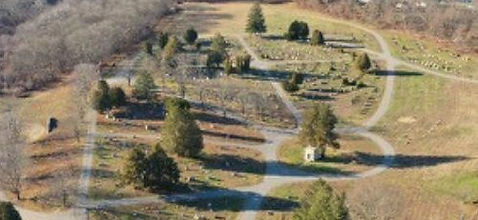
Map Stop 4
Windham Center Cemetery
Also known as the Old Burying Ground, the cemetery on Windham Center Road, received its first burial in 1730. Thomas Bingham died in his 88th year. Remarkably, the artistry of his headstone is noted in online sources as carved by Obadiah Wheeler (born in Norwich and buried in Newtown Village Cemetery, Fairfield Co.). Wheeler was well known for his ornate carvings.
The cemetery is still active and available for burials.

Map Stop 5
Windham Bank
Windham Bank, established in 1832, later became the home of the Windham Free Library in 1893. As with all banks, at the time, Windham Bank issued currency. Their dollar bill displays an image of the famous frog. Images of Colonel Dyer and Brigadier General Elderkin.

Map Stop 6
Site of Famous Frog Battle
Many stories have been told about the Frog Battle of Windham Center. The tales begin in the mid 1750's, during the tension surrounding the French and Indian War. Local town's folk became alarmed by loud sound from beyond the town center. Fearing an attack by natives they took shelter. Two heros appear to have emerged from the fight and later served as military leaders in the American Revolution: Col Eliphalet Dyer, and Brig. General Jedediah Elderkin.

Map Stop 8
Dr. Hunt's Office
Found on Windham Center Green and owned by the adjacent Windham Library is the small gambrel-roofed former office of Dr. Chester Hunt.
Built in 1790, it originally served as the office of Sheriff Shubel Abbe and was located behind his house at the south end of Windham Green. Abbe’s property was purchased in 1819 by Dr. Chester Hunt who then used the office until his death in 1869.
The building was moved in 1948 to a spot between two other houses on North Road, and was moved again in the 1980s to its current location where it was restored in honor of Julian Alden Weir and his wife, Ella Baker Weir, by his daughter, Cora Weir Burlingham and grandson, Charles Burlingham, Jr.
The Library has renovated the office’s exterior and opens it as a museum for special occassions.

Map Stop 9
Windham Inn
The Windham Inn has stood at the north end of Windham Green since 1783. Originally called the Windham House, until about 1890. Its appearance and structure was changed from a three story building to the present two stories when structural issues were revealed in 1850. A large front porch was added at some point and later removed
In recent, twentieth century, history the Inn was converted to apartments. However, age and neglect forced it closure. Local efforts have been marshaled to save the Inn from destruction. Grants are allowing continued restoration.
Stories persist that the ghost of Elizabeth (Betsy) Shaw remains at the inn. Betsy, as an unmarried woman, had been tried and hanged for the death of her child in 1744. Unexplained phantasms, including mysterious unshelving of books colored blue, and the whining of dogs entering the building, have been reported on “ghost hunting” websites.

Map Stop 11
Rochambeau Camp
Keeping with their long standing opposition to the British, Jean-Baptiste-Donatien de Vimeur, comte de Rochambeau, a French nobleman and general of the army, played a major role in the American Revloution. He moved about 5000 troops through Connecticut, from Rhode Island to what would become the decisive battle of Yorktown, Virginia.
A brigade of the French forces camped along the Shetucket River at the present day site of the Shetucket Plains Road Recreation Park.
It is not difficult to imagine the broad flat area with soldiers and their equipment.

Map Stop 12
Railroad Station Site
Willimantic was a rail hub with over fifty trains a day carrying the well-to-do between New York and Boston, delivering immigrants and raw cotton for thread manufacturing.
A wooden depot was built in the 1850s. Then in 1892, a glorious new building, named Union Station, was built near Railroad Street and Riverside Drive.
The most famous train through Willimantic ran along what was called the Airline Route. An express carried passengers from New York to Boston aboard the New England Limited. For a while it was nicknamed “The Ghost Train” and “The White Train” because of its white exterior. The train ran express, with one stop, in Willimantic. Here, a new engine and dining car were switched on for the second leg of the trip.
The White Train marketing ploy lasted only a few years.
Today you can hike the Airline State Park Trail. By 1950 the only passenger train to travel through was the New York, New Haven and Hartford because of the popularity of the automobile. The floods of 1955 ruined railroad property and ended passenger trains in Willimantic.


Map Stop 13
Willimantic River
The river runs south from Stafford Springs through town where it joins the Natchaug River and forms the Shetucket River which flows to Norwich. The river "drops" about 90 feet as it flows down the narrow gorge it cut through gneiss granite. The river provided hundreds of horsepower that turned mill wheels. Mills, large and small, were built along the northern bank of the river.

Map Stop 14
Old Post Office
Now the home of Willimantic Brewing Company. The former U.S. Post Office of neoclassic architecture was built in 1909 from Indiana limestone. The mail came to town by railroad.
The popular restaurant and brewery features the beautiful original woodwork and marble of the post office.

Map Stop 15
Windham Town Hall
The 1896 Town Hall is a five-story brick building designed by Warren Richard Briggs. The structure contains 1.25 million bricks and cost $73,000. The clock was donated in memory of mill manager Whiting Hayden. The building once housed the city jail, the library, the police station, the Grand Army of the Republic room and the court house.

Map Stop 16
Capitol Theatre
The theatre was built in 1926 to present live shows and movies. The building was designed by Archibald Sharpe and had 1,224 seats, 800 leather seats on the bottom, 400 in the balcony, and four private boxes, with six seats each. The stage was 80 feet wide and 36 feet deep. Under the stage were twelve dressing rooms and a chorus room. The theatre closed in October 1973.
The theater opened on January 21, 1926, with a mixed program. There were live acts including the Jean Jackson Bicycle Troupe, the Seven Rainbow Girls - "full of pep and personality," and more. Admission was 35¢ for balcony seating and 50¢ on the orchester floor. The ticket included a modern silent photoplay, His Secretary, staring heart throb Norma Shearer.
The final movie schedule included Willy Wonka and the Chocolate Factory and Paper Moon. It is said that a ghost, of a young actress, haunts the building.
In recent years, the building has been renovated into a performing arts magnet high school, ACT, for Arts at the Capitol Theatre.


Map Stop 17
First Congregational Church
In 1828, an ecclesiastical council was formed and named Doctor Samuel Nott, of Franklin, as moderator. This marked the start of the First Congregational church of Willimantic.
On February 24th, 1869, the congegation decided to build the present church. They appointed a building committee composed of John Tracy, Allen Lincoln, William C. Jillson and the pastor. In July 1869, the corner stone was laid, and within a year from the church was dedicated to the worship of God.
The stained glass windows were each a gift from church members. A close viewing inside reveals the stories and dedications for each of the windows.
The whole cost of church, grounds, chapel, furniture, organ and all, amounted to $46,700, and by October 1872, it had all been paid, so that the society was free from debt.

Map Stop 18
Nathan Hale Bldg
One of two grand hotels on historic Main Street of Willimantic, Connecticut, The Nathan Hale Hotel hosted movers and shakers from New York and Boston during the golden age of train travel. Even though the trip between the two cities was six hours at the height of train travel, many travelers chose to stay over, to dine and rest, in Willimantic before continuing their journey.
The railroad brought the customers. And a new hotel, built in 1926, was constructed on the site of Youngs Hotel. Youngs’ had been built about 1892. However, it and the Hooker began showing their age, and the new Nathan Hale Hotel was built.
It boasted a polished granite lobby floor, and a restaurant with a skylight. But its day, too, soon passed. Railroad travel gave way to automobiles; Willimantic was no longer the halfway mark.
Nathan Hale Hall briefly served as dormitory and office space for Eastern Connecticut State University students.
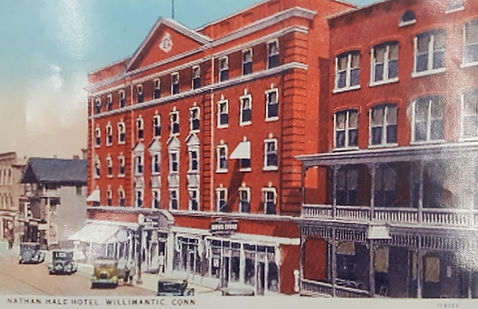
Map Stop 19
Hotel Hooker
The Hooker was founded by Chauncey Hooker. The grand opening of the fine hotel was February, 1887. The building featured a hydraulic elevator, and bathrooms on each floor. There were state of the art steam radiators, gas lighting, speaking tubes and sinks with hot water in every room. The building had magnificent porches on two floors along the front of the building.
The hotel’s restaurant could cater to 250 people. For many years the quality hotel hosted banquets and travelers who came by rail to visit or do business in Willimantic.
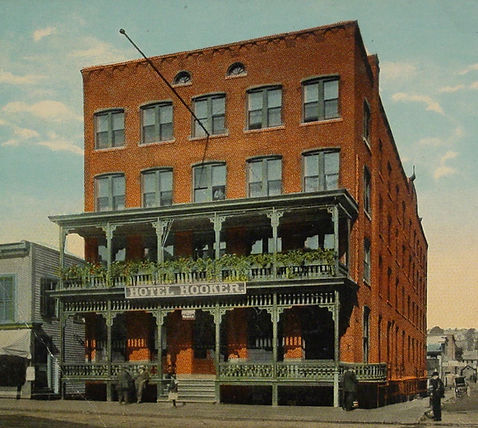
Map Stop 20
Franklin Hall
The three-story building was built in the early 1870s. The lower floor was used for retail like Burt Thompson’s grocery. The second floor was offices. The third floor was an auditorium for entertainment, concerts, lectures, union meetings and dances. The stage measured about 40 feet and the floor and balcony held about 350 persons.
The building now houses A Cupcake For Later offering the perfect spot to take a break.

Map Stop 21
Murray on Main
The distinctive brick building was built by H.C. Murray in 1893. His new store had steam heat, and both gas and electric lighting. It had the first elevator in town.
Murray opened the clothing and department store known as the Boston Store. The store carried clothing, hats, furniture and carpets. At one time it had a bridal shop, scouting and domestic departments. Murray was a Scotsman who came to Willimantic in the 1860s.
The building remained an upscale haberdashery, serving the well dressed men of Willimantic, until the end of the twentieth century.
Recent renovations have restored the facade and provides apartment space above the ground floor.
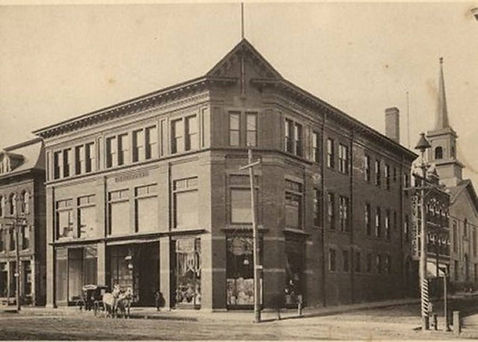
Map Stop 22
Willimantic Baptist Church
The church was organized October 20th, 1827. At first the school houses were used for meetings, but a spirit of opposition arose and they were debarred this privilege. With aid from abroad they succeeded in building a meeting house on the site at present occupied.
Bayles' History of Windham County, Connecticut (1889)
The church marks the eastern edge of the Main Street Historic District.
The present day church was built in 1844. It was designed by the renowned Mansfield architect, Edmund Fitch.

Map Stop 23
Jillson Square
The Jillson Park and Shaboo stage are on the site of three city streets, Union, Broad and Center, and some seventy buildings, both businesses and residences, that were demolished in a urban renewal project in the 1970s.
Many concerts and festivals are held here each year.
The city has been visited by Presidents Theodore Roosevelt, Howard Taft, and U.S. Grant.

Map Stop 24
Jillson House Museum
The Windham Historical Society now operates the museum in the house that was built by William Jillson in 1824. William was one of three brothers who built a mill to manufacture cotton cloth and yarns. They were one of the earliest industrialists who took advantage of the abundant energy in the “Land of Swift Waters.”
The building is built of granite quarried from the Williamantic River gorge. The same material was used to build the massive three story mill buildings. One of those mills still dominates the east end of the sity.
The house saw several different uses as warehouse space, as apartments and finally a single family home in 1920. During the redevelopment of the adjacent section of the city, it was rescued and restored by the Windham Historical Society.

Map Stop 25
Footbridge
TEMPORARILY CLOSED FOR REPAIRS
Built in 1907, the Footbridge connects Main Street and Pleasant Street. It is believed to be the longest bridge spanning a river, railroad and roadway east of the Mississippi.
As early as 1877 Willimantic knew an additional bridge of some sort was needed to connect the growing Main Street business district to the residential community spreading on the south side of town.
However, after nearly fifty years of meetings, petitions and budget hearings, the new Willimantic Footbridge was finally to be built.
Horses, wagons and pedestrians had crowded onto the existing bridges. Trolley or streetcar service was introduced in 1903, adding to congestion and danger.
Safety and convenience finally won out. The footbridge was completed in 1906, with the price tag less than $13,000.
Ooops. The engineer who was charged with purchasing the property across the river for the footbridge must have measured wrong. The place where the bridge comes out is not a straight line across. So the bridge has a dog leg angle in it. However, the real scandal turned out to be that the footbridge committee used town funds to hire an elegant carriage and team to arrive at the bridge dedication in grand style.
The Willimantic Footbridge is listed in the National Register of Historic Places. Its length is 635 feet. And, It has been noted as the only footbridge east of the Mississippi River crossing streets, railroad tracks and a river.


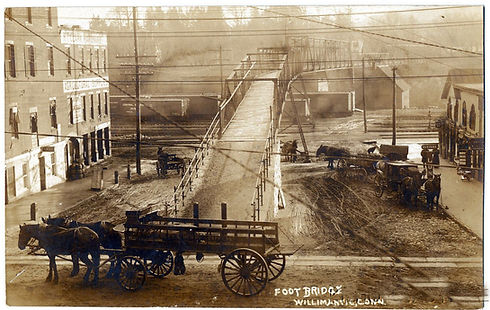
Map Stop 26
Willimantic Armory
The Armory was built in 1913. It served as a facility for the Connecticut National Guard until 1980, when the building was sold to developers who converted the building into apartments.
In 1909, a bill passed, allocating $50,000 for the construction of a single-company armory. A 300-by-160-foot lot was purchased from Samuel Chesbro for $6,500, and the architectural firm Whiton & McMahon was awarded the design contract. The builder, F. D. Kent, received $32,405 for construction.
The armory originally housed Company B of the 169th Infantry until the 1960s, when it was reassigned to the 248th Engineer Company. The facility remained the home of the 248th until the late 1970s, when a new armory was constructed in Norwich, Connecticut, and the unit was relocated. The armory was added to the National Register of Historic Places 1985.

Map Stop 27
Frog Bridge
Opened in 2000, the Thread City Crossing spans the river and rail tracks. The Frog on Spool sculptures are iconic symbols of Windham’s thread industry and the frog pond legend from 1754. The story is retold on a bronze plaque on the bridge.
The bridge repaced the Stone Arch Bridge, now repourposed as the Garden on the Bridge, for safety and traffic flow. The bridge permits traffic to connect Willimantic and Norwich. Numerous accidents and mishaps plagued the previous road with dangerous intersections and low clearance below the railroad trestle.
Visitors may see the frogs, named Manny, Willy, Windy, and Swifty, wrapped in hand knitted scarves in the winter.

Map Stop 28
Mill Museum
The Windham Textile and History Museum, known as the Mill Museum, building was built by the factory as the company store and library in 1877. The example of Queen Anne architecture houses social and industrial exhibits since 1987.

Map Stop 29
Windham Mills
Several distinctive stone factory buildings remain on the site of the Willimantic Linen Company (1854-1898)/American Thread Company (1898-1985). Among the many “firsts” in town, the Linen Company was the first to produce thread on wooden spools and to build the first mill designed to be illuminated by electricity.

Map Stop 30
Garden on the Bridge
The Stone Arch Bridge, built about 1857, was sometimes referred to as the Jillson Hill Bridge or the Lower Bridge. At the time it was one of two bridges crossing the river.
Willimantic Linen Co. contributed to the cost of building the stone bridge. In part because it crosses the Willimantic River surrounded by Willimantic Linen Co. mill buildings.
The bridge provided easy access for mill employees who lived on the south side of the river. There many examples of the Victorian mansions afforded by the company's officers can be seen just across the bridge. The Oaks neighborhood, also for mill employees, built by Willimantic Linen Co., was in easy walking distance between home and work.
The bridge was built with the same gneiss granite, quarried from the river, as were the mill buildings still standing.
It became a pedestrian walkway, a garden, and an intimate performance venue, when the Frog Bridge was opened.



